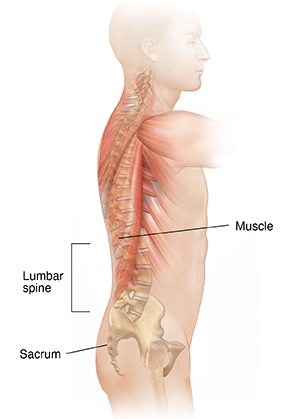Understanding Lumbosacral Strain
Lumbosacral strain is a medical term for an injury that causes low back pain. The lumbosacral area (low back) is between the bottom of the ribcage and the top of the buttocks. A strain is tearing of muscles and tendons. These tears can be very small but still cause pain.

How a lumbosacral strain happens
Muscles and tendons connected to the spine can be strained in a number of ways:
-
Sitting or standing in the same position for long periods of time. This can harm the low back over time. Poor posture can make low back pain more likely.
-
Moving the muscles and tendons past their usual range of motion. This can cause a sudden injury. This can happen when you twist, bend over, or lift something heavy. Not using correct technique for sports or tasks like lifting can make back injury more likely.
-
Accidents or falls
Lumbosacral strain can be caused by other problems, but these are less common.
Symptoms of lumbosacral strain
Symptoms may include:
-
Pain in the back, often on one side
-
Pain that gets worse with movement and gets better with rest
-
Inability to move as freely as usual
-
Swelling, slight redness, and skin warmth in the painful area
Treatment for lumbosacral strain
Low back pain often goes away by itself within several weeks. But it often comes back. Treatment focuses on reducing pain and avoiding further injury. Bed rest is usually not recommended for low back pain. Treatments may include:
-
Avoiding or changing the action that caused the problem. This helps prevent injuring the tissues again.
-
Prescription or over-the-counter medicines. These help reduce inflammation, swelling, and pain. NSAIDs (nonsteroidal anti-inflammatory drugs) are the most common medicines used. Medicines may be prescribed or bought over the counter. They may be given as pills. Or they may be put on the skin as a gel, cream, or patch.
-
Cold or heat packs. These help reduce pain and swelling.
-
Stretching and other exercises. These improve flexibility and strength.
-
Physical therapy. This usually includes exercises and other treatments.
-
Injections of medicine. This may relieve symptoms. The medicine is usually a corticosteroid. This is a strong anti-inflammatory medicine.
If these treatments don't relieve symptoms, your healthcare provider may order imaging tests to learn more about the problem. Sometimes you may need surgery.
Possible complications of lumbosacral strain
If the cause of the pain is not addressed, symptoms may return or get worse. Follow your healthcare provider’s instructions on lifestyle changes and treating your back.
When to call your healthcare provider
Call your healthcare provider right away if you have any of these:
-
Fever of 100.4°F (38°C) or higher, or as directed by your provider
-
Chills
-
Numbness, tingling, or weakness
-
Problems with bowel or bladder control, or problems having sex
-
Pain that does not go away, or gets worse
-
New symptoms
Online Medical Reviewer:
Raymond Turley Jr PA-C
Online Medical Reviewer:
Stacey Wojcik MBA BSN RN
Online Medical Reviewer:
Thomas N Joseph MD
Date Last Reviewed:
5/1/2022
© 2000-2024 The StayWell Company, LLC. All rights reserved. This information is not intended as a substitute for professional medical care. Always follow your healthcare professional's instructions.